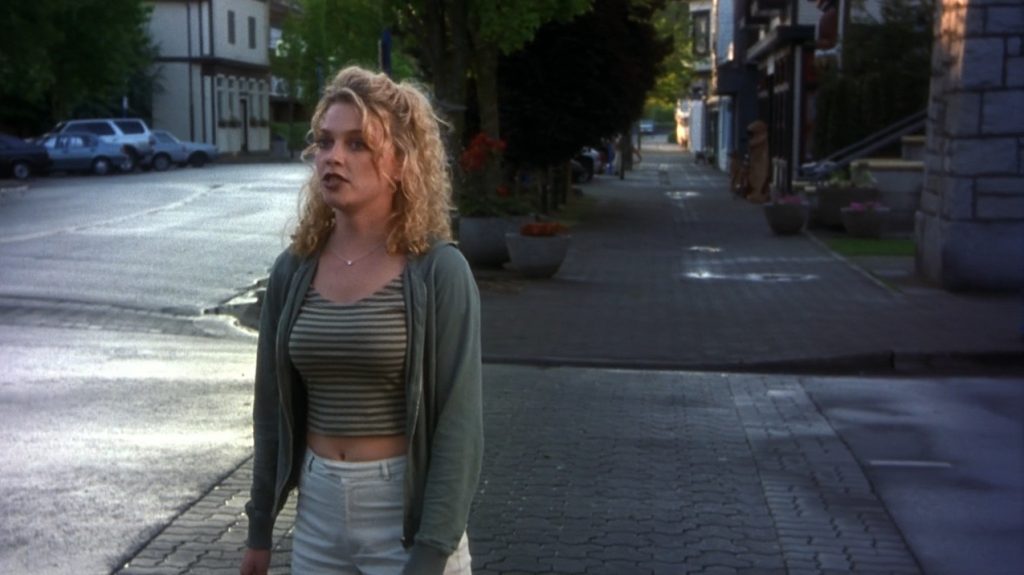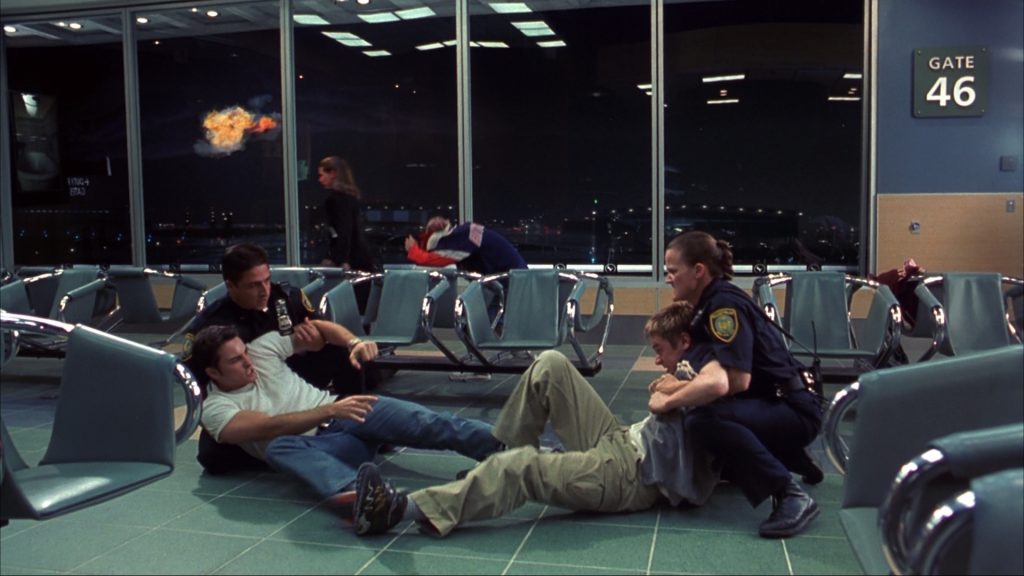Ostensibly yet another teen-focused horror movie in which protagonists
get picked off one by one, Final Destination represents a significant paradigm shift. By the end of the 1990s the slasher/killer was played out as a horror trope.Not even self-referential parody could make a masked murderer into an interesting antagonist. Even before the first plane hit the North Tower, it seems that audiences were searching for a new source of dread, something less cartoonish, something that couldn’t be blamed on an unhappy childhood, or a revenge mission. The new millennium brought with it a new unease, a feeling that the evil in the world cannot be contained inside one masked, wise-cracking human. Step forward the most ancient and enduring of human adversaries: Death.
The Final Destination killer has no cumbersome backstory, no narcissistic mother waiting in the shadows, no daughters/sons unaware of their parentage. It has no Achilles heel. It has everyone in its sights and no one – virgins and geeks are in just as much danger as cheerleaders. The rules are simple, without caveats: if you are a character in a Final Destination movie, you are going to die. It’s just a matter of when, where and – most importantly for the entertainment factor of these movies – how. This grim premise is actually a very effective crowd pleaser when properly
handled, and has effectively sustained five entries in the franchise,
with a sixth in development.
The Final Destination movies are all about anticipation. Hitchcock identified how audiences take pleasure in waiting first and best:
“You and I are sitting here . . . . suddenly a bomb goes off and up we go, blown to smithereens. What have the audience had while watching this scene? Five or ten seconds of shock. Now we do the scene over again, it’s a five minute scene. You and I are talking about football, something very innocuous, but the audience are informed by a method unknown to us that there’s a bomb under the table and it’s going to go off in five minutes. Now this innocuous conversation about football becomes very potent. “Don’t talk about football, there’s a bomb under there”, that’s what they want to tell us, as the bomb ticks away and we keep telling the audience there’s a minute to go; half a minute and finally ten seconds. That is when it must not go off. If we let it go off, the audience will be as mad as hell with us, they’ll be disgusted. They’ll say, “Don’t go and see that movie or that play”. Your toe MUST touch the bomb at the last minute, you must look under the table, grab the bomb and throw it out of the window, then it can go off; but you and I must be saved. An audience needs that relief after you’ve put them through the wringer.”
Alfred Hitchcock quoted in “Heard In The Wings” (1971), edited by Roderick Bloomfield


While Hitchcock-era audiences were aware of imminent disaster, the onscreen characters themselves, however, remained blissfully ignorant
of the danger under the table. By the 2000s roll around, the Final
Destination protagonists are fully aware of their impending demise, and half of the pleasure of the films (particularly Final Destination 2) is watching them squirm under the pressure. These teens want out of the situation they find themselves in, but there is only one exit.
Once Alex (Devon Sawa) figures out his escape from death-by-fireball is only temporary, his goal involves dodging his fate for as long as possible, rather than long term survival. A friendly mortician (genre stalwart Tony Todd) advises Alex and Clear that it’s pointless to fight their destiny – we’re “all part of Death’s sadistic design”. Not even the pluckiest Final Girl could triumph over this threat.
Alex and his fellow survivors enter a brave new world where fatal possibilities lurk around every corner. The “heimlich” is now truly “unheimlich”. Freud would be fascinated. The underlying perils of middle class, small town American existence are thrown into sharp relief. It’s not the big, extraordinary things that get you (a crashing plane), but the small, everyday objects: a washing line, a leaky cup, an unexpected bus. This makes for delicious viewing – audiences are thrust into a sadistic PSA highlighting bathroom, kitchen, and level crossing safety. Each death is accidental, almost self-inflicted, the consequence of a series of small decisions, easily made, ultimately fatal.
This approach offers great opportunities for SFX, a hallmark of this franchise. Apart from the spectacular exploding jet engine at the top, the circumstances of each death are played out in loving detail, with skilful cinematography enhancing the suspense. Death is heralded by nothing more than steam from a kettle, or water oozing from a drain. As soon as the sequence kicks in, every household object becomes potentially deadly, and the audience are invited to predict which one will deliver the fatal blow.
The physical death sequences have much in common with slapstick (Tod flailing around in his bathroom, Mrs Lewton regarding every kitchen implement with paranoid suspicion), only a fatality replaces the punchline. Very quickly, the audience learns what to expect once lights start flashing and leaves start rustling, and the pleasure of this entire movie franchise revolves around the stylish fulfilment of those expectations.


Final Destination is extremely self aware as a text (all the characters are named for horror movie greats – Browning, Chaney, Lewton), and tips its hat to the genre conventions (Alex: “I’m not going Dahmer on you guys, this just is.”). But the filmmakers attempt to bring us something fresh, not just another post-Scream witticism. Final Destination begins with an explosion, the death of hundreds, the worst thing that can happen. Most horror movies would reserve this kind of destruction for their climax – this approach turns Hitchcock’s “bomb under the table” on its head. The “innocuous conversation about football” lasts throughout the remainder of the narrative, with more, smaller bombs exploding at intervals as character after character collides with their delayed fate.
It’s inevitable that the protagonists we care most about should be left till last, but the narrative baulks at coming to the most logical, merciless conclusion. The movie originally ended with Alex’s death, but this failed with test audiences (the filmmakers should have listened to Hitchcock and his stipulation that an audience needs relief). $2 million worth of re-shoots reconfigured the ending so his fate is left hanging in the balance – alive, for now, but ultimately doomed.
Post 9/11, Final Destination plays as something of a comfort. Its central message (you are more likely to be killed by a tea kettle than an anthrax attack) reclaims Death as an entity, pulling it back out of the realm of capering, masked, cartoonish killers with supernatural powers and smart mouths. The franchise also represents a world in which tragic mass deaths occur as accidents, not as part of a terrorist plot. In Final Destination, Death is once again real, domestic, mundane, but still the stuff of nightmares.
The movie encapsulates a brief moment of innocence at the top of the century when a plane erupting in a fireball could be entertainment. As the 2000s wore on, Death became even more everyday. War casualties dominated news reports until they became too commonplace to report. Cinema audience’s tastes ran to torture porn and the straight-to-DVD market exploited censorship loopholes to make “uncut” mean “hacked to pieces with a blood-soaked chainsaw”. But for the teenage protagonists of Final Destination and its sequels, Death becomes a fresh concept, as they are suddenly, forcibly reminded of their own mortality. While audiences are entertained by the elaborate accidents that befall the characters, the movies leave a chilling aftertaste. The horrors of Saw or Hostel wash over the viewer, their atrocities so beyond the realm of everyday experience that they have no impact, but Final Destination hits home. Literally. Your kitchen will never be a safe haven again.
Sequels
The beauty of the Final Destination franchise is the formula – rinse, change context, repeat. Each movie involves a teen-heavy group who dodge Death during the initial tragic action sequence, only to succumb in an equally gory/painful fashion at some point in the next 90 minutes.
- Final Destination 2 (2003) involves a massive, multi-vehicle freeway accident.
- Final Destination 3 (2006) centers on a rollercoaster disaster
- The Final Destination (2009) is shot in HD 3D and is set at the scene of a speedway tragedy, with racecars spinning off the track into the stadium
- Final Destination 5 (2011) goes full Mothman with a bridge collapse.
Back to 2000s Horror Movies>>>>>>>
Further reading
- Is Final Destination the Best Horror Franchise in History by Brendan Morrow (Bloody Disgusting, April 12, 2016)
- Collins Crypt: Giving the Final Destination Series its Due by Brian Collins (Birth. Movies. Death, June 6, 2017)